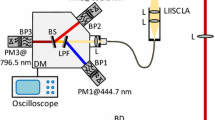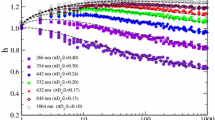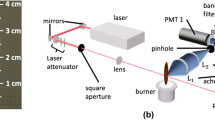Abstract
Theoretical analysis and numerical calculations were conducted to investigate the relationship between soot volume fraction and laser-induced incandescence (LII) signal within the context of the auto-compensating LII technique. The emphasis of this study lies in the effect of primary soot particle diameter polydispersity. The LII model was solved for a wide range of primary soot particle diameters from 2 to 80 nm. For a log-normally distributed soot particle ensemble encountered in a typical laminar diffusion flame at atmospheric pressure, the LII signals at 400 and 780 nm were calculated. To quantify the effects of sublimation and differential conduction cooling on the determined soot volume fraction in auto-compensating LII, two new quantities were introduced and demonstrated to be useful in LII study: an emission intensity distribution function and a scaled soot volume fraction. When the laser fluence is sufficiently low to avoid soot mass loss due to sublimation, accurate soot volume fraction can be obtained as long as the LII signals are detected within the first 200 ns after the onset of the laser pulse. When the laser fluence is in the high fluence regime to induce significant sublimation, however, the LII signals should be detected as early as possible even before the laser pulse reaches its peak when the laser fluence is sufficiently high. The analysis method is shown to be useful to provide guidance for soot volume fraction measurements using the auto-compensating LII technique.











Similar content being viewed by others
References
A.C. Eckbreth, Effects of laser-modulated particle incandescence on Raman scattering diagnostics. J. Appl. Phys. 48(11), 4473–4479 (1977)
L.A. Melton, Soot diagnostics based on laser heating. Appl. Opt. 23(13), 2201–2208 (1984)
J. Liggio, M. Gordon, G. Smallwood, S.-M. Li, C. Stroud, R. Staebler, G. Lu, P. Lee, B. Taylor, J.R. Brook, Are emissions of black carbon from gasoline vehicles underestimated? Insights from near and on-road measurements. Environ. Sci. Tech. 46, 4819–4828 (2012)
B.F. Kock, C. Kayan, J. Knipping, H.R. Orthner, P. Roth, Comparison of LII and TEM sizing during synthesis of iron particle chains. Proc. Combust. Inst. 30, 1689–1697 (2005)
F. Cignoli, C. Bellomunno, S. Maffi, G. Zizak, Laser-induced incandescence of Titania nanoparticles synthesized in a flame. Appl. Phys. B 96, 593–599 (2009)
R.L. Vander Wal, K.J. Weiland, Laser-induced incandescence: development and characterization towards a measurement of soot-volume fraction. Appl. Phys. B 59, 445–452 (1994)
R.L. Vander Wal, Laser-induced incandescence: detection issues. Appl. Phys. B 35(33), 6548–6559 (1996)
C.R. Shaddix, K.C. Smyth, Laser-induced incandescence measurements of soot production in steady and flickering methane, propane, and ethylene diffusion flames. Combust. Flame 107, 418–452 (1996)
R.L. Vander Wal, Laser-induced incandescence: excitation and detection conditions, material transformations and calibration. Appl. Phys. B 96, 601–611 (2009)
C. Schulz, B.F. Kock, M. Hofmann, H. Michelsen, S. Will, B. Bougie, R. Suntz, G. Smallwood, Laser-induced incandescence: recent trends and current questions. Appl. Phys. B 83, 333–354 (2006)
B. Quay, T.-W. Lee, T. Ni, R.J. Santoro, Spatially resolved measurements of soot volume fraction using laser-induced incandescence. Combust. Flame 97, 384–392 (1994)
T. Ni, J.A. Pinson, S. Gupta, R.J. Santoro, Two-dimensional imaging of soot volume fraction by the use of laser-induced incandescence. Appl. Opt. 34(30), 7083–7091 (1995)
R.T. Wainner, J.M. Seitzman, Soot measurements in a simulated engine exhaust using laser-induced incandescence. AIAA J. 37(6), 738–743 (1999)
Dec, J.E., zur Loye, A.O., Siebers, D.L., Soot distribution in a D.I. diesel engine using 2-D laser-induced incandescence imaging, SAE paper 910224 (1991)
N.P. Tait, D.A. Greenhalgh, PLIF imaging of fuel fraction in practical devices and LII imaging of soot. Ber. Bunsenges. Phys. Chem. 97(12), 1619–1625 (1993)
P.-E. Bengtsson, Aldén, Soot-visualization strategies using laser techniques (Laser-induced fluorescence in C2 from laser-vaporized soot and laser-induced soot incandescence). Appl. Phys. B 60, 51–59 (1995)
D.J. Bryce, N. Ladommatos, H. Zhao, Quantitative investigation of soot distribution by laser-induced incandescence. Appl. Opt. 39(27), 5012–5022 (2000)
B. Axelsson, R. Collin, Laser-induced incandescence for soot particle size and volume fraction measurements using on-line extinction calibration. Appl. Phys. B 72, 361–372 (2001)
D.R. Snelling, G.J. Smallwood, F. Liu, Ö.L. Gülder, W.D. Bachalo, A calibration-independent laser-induced incandescence technique for soot measurement by detecting absolute light intensity. Appl. Opt. 44(31), 6773–6785 (2005)
S. De Iuliis, F. Cignoli, G. Zizak, Two-color laser-induced incandescence (2C-LII) technique for absolute soot volume fraction measurement in flames. Appl. Opt. 44(34), 7414–7423 (2005)
B. Mewes, J.M. Seitzman, Soot volume fraction and particle size measurements with laser-induced incandescence. Appl. Opt. 36(3), 709–717 (1997)
H. Bladh, J. Johnsoon, P.-E. Bengtsson, On the dependence of the laser-induced incandescence (LII) signal on soot volume fraction for variations in particle size. Appl. Phys. B 90, 109–125 (2008)
J. Reimann, S.-A. Kuhlmann, S. Will, Improvement in soot concentration measurements by laser-induced incandescence (LII) through a particle size correction. Combust. Flame 153, 650–654 (2008)
F. Migliorini, S. De Iuliis, S. Maffi, F. Cignoli, G. Zizak, Investigation on the influence of soot size on prompt LII signals in flames. Appl. Phys. B 96, 637–643 (2009)
Ü.O. Köylu, G.M. Faeth, Radiative properties of flame-generated soot. J. Heat Transf. 115, 409–417 (1993)
G.W. Mulholland, R.D. Mountain, Coupled dipole calculation of extinction coefficient and polarization ratio for smoke agglomerates. Combust. Flame 119, 56–68 (1999)
F. Liu, G.J. Smallwood, The effect of particle aggregation on the absorption and emission properties of mono- and polydisperse soot aggregates. Appl. Phys. B 104, 343–355 (2011)
F. Liu, G.J. Smallwood, D.R. Snelling, Effects of primary particle diameter and aggregate size distribution on the temperature of soot particles heated by pulsed lasers. JQSRT 93, 301–312 (2005)
C.F. Bohren, D.R. Huffman, Absorption and Scattering of Light by Small Particles (Wiley, New York, 1983)
F. Liu, K.J. Daun, D.R. Snelling, G.J. Smallwood, Heat conduction from a spherical nano-particle: status of modeling heat conduction in laser-induced incandescence. Appl. Phys. B 83, 355–382 (2006)
G.J. Smallwood, D.R. Snelling, F. Liu, Ö.L. Gülder, Clouds over soot evaporation: errors in modeling laser-induced incandescence of soot. J. Heat Transf. 123, 814–818 (2001)
Snelling, D.R., Liu, F., Smallwood, G.J., Gülder, Ö.L., Evaluation of the nanoscale heat and mass transfer model of LII: prediction of the excitation intensity, NHTC2000-12132, in Proceedings of the 34th National Heat Transfer Conference, Pittsburgh, Pennsylvania, 20–22 August 2000
H.A. Michelsen, F. Liu, B.F. Kock, H. Bladh, A. Boiarciuc, M. Charwath, T. Dreier, R. Hadef, M. Hofmann, J. Reimann, S. Will, P.-E. Bengtsson, H. Bockhorn, F. Foucher, K.-P. Geigle, C. Mounaïm-Rousselle, C. Schulz, R. Stirn, B. Tribalet, R. Suntz, Modeling laser-induced incandescence of soot: a summary and comparison of LII models. Appl. Phys. B 87, 503–521 (2007)
H.A. Michelsen, Understanding and predicting the temporal response of laser-induced incandescence from carbonaceous particles. J. Chem. Phys. 118, 7012–7045 (2003)
S. Schraml, S. Dankers, K. Bader, S. Will, A. Leipertz, Soot temperature measurements and implications for time-resolved laser-induced incandescence (TIRE-LII). Combust. Flame 120, 439–450 (2000)
K. Tian, F. Liu, K.A. Thomson, D.R. Snelling, G.J. Smallwood, D. Wang, Distribution of the number of primary particles of soot aggregates in a nonpremixed laminar flame. Combust. Flame 138, 195–198 (2004)
F. Liu, B.J. Stagg, D.R. Snelling, G.J. Smallwood, Effects of primary soot particle size distribution on the temperature of soot particles heated by a nanosecond pulsed laser in an atmospheric laminar diffusion flame. Int. J. Heat Mass Transf. 49, 777–788 (2006)
F. Liu, M. Yang, F.A. Hill, D.R. Snelling, G.J. Smallwood, Influence of polydisperse distributions of both primary particle and aggregate size on soot temperature in low-fluence LII. Appl. Phys. B 83, 383–395 (2006)
Acknowledgments
Financial support by NRCan PERD AFTER Project C23.006 and NRCan PERD P&E Project C11.008 is gratefully acknowledged.
Author information
Authors and Affiliations
Corresponding author
Rights and permissions
About this article
Cite this article
Liu, F., Smallwood, G.J. Relationship between soot volume fraction and LII signal in AC-LII: effect of primary soot particle diameter polydispersity. Appl. Phys. B 112, 307–319 (2013). https://doi.org/10.1007/s00340-012-5330-0
Received:
Accepted:
Published:
Issue Date:
DOI: https://doi.org/10.1007/s00340-012-5330-0




